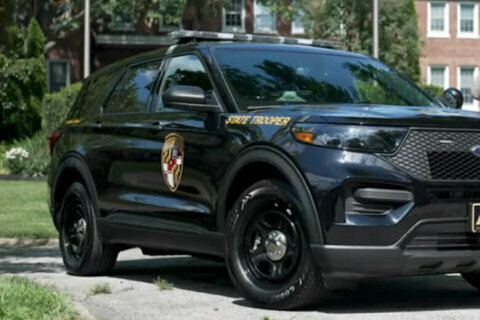This article was republished with permission from WTOP’s news partners at Maryland Matters. Sign up for Maryland Matters’ free email subscription today.
This content was republished with permission from WTOP’s news partners at Maryland Matters. Sign up for Maryland Matters’ free email subscription today.
A new Chesapeake Bay crossing must be built alongside the existing Bay Bridge if it is to provide maximum traffic relief, the head of the Maryland Transportation Authority said on Tuesday.
After three years of analysis about where a new bay crossing should go, the MDTA announced it will study three potential “corridors,” all of them connecting Anne Arundel County to the Eastern Shore.
Although a final decision on where to build a new span – let alone actual construction – is years away, Anne Arundel officials on Tuesday expressed dismay with the Hogan administration’s approach.
“Anne Arundel is looking down the barrel of a gun right now,” County Executive Steuart Pittman (D) said in an interview.
Gov. Lawrence J. Hogan Jr. (R) announced his intention to explore the possibility of a new Chesapeake Bay crossing three years ago, saying it would provide desperately needed traffic relief. The three options revealed Tuesday were chosen from an original list of 14 potential crossing sites that stretched from the outskirts of the Baltimore metropolitan area (a Harford County-to-Cecil County crossing) to Southern Maryland (a crossing in the St. Mary’s County-to-Somerset County corridor).
Along with the federally-mandated “no build” option, the authority’s top choices will now undergo the more rigorous analysis required by the National Environmental Policy Act.
James F. Ports Jr., the transportation authority’s executive director, said the option that delivers the most traffic relief is the one that would be built close to the existing Chesapeake Bay Bridge spans.
“While the No-Build alternative and three preliminary corridor alternatives are being included in the federal environmental process for further study, traffic models indicate that one of the three, building a third crossing within the same corridor as the existing Bay Bridge (Corridor 7), would have the most positive impact on reducing traffic,” Ports said in a statement.
Four of the 14 original corridors have a terminus in Anne Arundel, and county officials and residents have been anticipating the news that arrived in an MDTA news release on Tuesday — many with a sense of dread.
They already contend with serious delays along U.S. 50, particularly during beach season, with significant traffic overflow on county and neighborhood roads from Thursday evening until Sunday night — and whenever there is an accident or inclement weather.
Pittman criticized the state for favoring crossings that would be built in his community. One option would extend a road from Pasadena to the bay, north of the Bay Bridge, and would hit the Eastern Shore in Rock Hall. Another option would take the crossing from Crofton, south of the Bay Bridge, and terminate near Easton.
“Any of the three options will be severely disruptive to existing communities and sensitive environmental areas,” Pittman said in a statement.
“All three options could destroy parks along the Chesapeake Bay, at a time when we are trying to expand public water access.”
He said the state should focus more on “forward-looking public transit options that this study dismisses,” adding, “Let’s not build yesterday’s bridge tomorrow.”
John Townsend II, head of government affairs for AAA Mid-Atlantic, said the increase in traffic on the existing spans and the need for improved safety make it imperative that Maryland increase capacity.
“The bridge is antiquated,” he said of the current structures, which opened in 1952 and 1973. (Official name: the Gov. William Preston Lane Jr. Memorial Bridge.)
“The state will have to make some hard choices, and the question remains whether elected officials have the political willpower to do it.”
Townsend noted that there have been numerous serious incidents on the spans in recent years and that two of the three recent fatalities occurred when the westbound span was in “contra-flow” mode, in which cars going in the opposite direction are sharing three lanes.
In narrowing their options from 14 to three, state officials said they looked at engineering factors such as the length of crossing needed for each alternative, both on land and water — a big driver of cost.
“Approach infrastructure” for certain alignments would further add to the expense.
Corridor 7 – the site favored by Ports – is the shortest of the 14 alternatives.
The MDTA also considered “indirect effects” from each option, including whether “new access to rural lands could lead to pressure for new development,” proximity to employment centers and county growth plans.
The Transportation Authority will present the no-build alternative, the three top-performing corridor alternatives, and the original 14 alternatives for public review and comment at six open houses in September and October.
The events will be held on both sides of the Chesapeake Bay.
Anne Arundel County Council Chairman Andrew C. Pruski (D) said it is essential that transportation planners listen to residents and local officials before making a final decision.
“Not only is it construction impact, but also the vision of where we want to go for transportation. To me, rapid bus service, ferries and other modes also need to be considered before we go down this path.”
The state’s maps don’t include exact bridge locations, pending further study. But Pittman said all three of the Transportation Authority’s top options would bring harm.
“The middle crossing (Corridor 6) appears to go through Downs Park,” he said. “The middle crossing (Corridor 7) appears to go through Sandy Point State Park. The southern crossing (Corridor 8) appears to go through Beverly Triton Nature Park.”
In an interview, Pittman also expressed skepticism about the state’s projections for traffic in 2040 and said it’s “possible” that the two Anne Arundel options that run north or south of the Bay Bridge may have been floated to make the third option more palatable.
“I hope they’re not serious about the other two,” Pittman said.
“Either way,” he added, “they’ll be hearing from Anne Arundel County.”
Michael Ricci, a spokesman for Hogan, suggested Pittman’s criticisms were misguided.
“Governor Hogan is unequivocal about this: the only serious option he supports is adding a span to the current Bay Bridge,” Ricci said in an email. “What is completely unserious is Mr. Pittman issuing a frantic, knee-jerk press release that demonstrates little to no understanding of traffic patterns, projections, or the nature of the traffic that crosses the bridge. Once he finally gets up to speed, we look forward to working with his administration as we advance this important project.”
Josh Kurtz contributed to this report.







